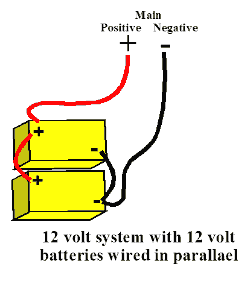If I have a 12vdc 100AH battery that has a BMS in it that is 100A max discharge, does this mean if I parallel two of them together I can do a max 200A discharge now?
Max discharge rate isn’t set by the BMS, it’s set by battery chemistry and the internal resistance of said chemistry.
So the only way to get 200A discharge is to have 2 batteries in parallel.
Theoretically yes, you could have a 200amp discharge at 12V. Check the spec. sheets on your batteries carefully, how long are they actually capable of suppling 100amps each?
Obviously select an appropriate fuse size from each battery to the bus bar and then from the bus to load.
If you’re asking this question, are you sure you want to play around with 200 amp circuits?!
Really? What type of battery is @nicklee using? What does the Battery Management System do?
The mind boggles.
No I read the OP’s post as him wanting to have two BMS in one battery and hope to get 200 amp discharge out of that one battery, I missed the part that he meant battery, not 2 BMS in one battery.
You can’t get more than 100 amp out of a single battery if that is what they are rated for. You can damage the battery this way.
I’m assuming he is either using lithium ion batteries, lipo, or life batteries.
Because lead acid batteries do NOT need a BMS.
But why does the OP want 200 amp out of batteries? Is he trying to weld something?
You’re the only one who thought this was about getting more than 100 amps from a single battery.
Somebody better tell all the manufacturers of BMS for lead acid batteries they’re wasting their time then! Huasu Battery Management System (BMS) for Lead Acid Battery
There are thousands of applications, other than welding, where this might be required. I believe the OP has a camper van or similar.
Lead acid batteries are crap for what he’s using it for then if the application is camper. They’re used in the past because that was all that they had but they suck badly. And you have to use deep cycle batteries or else if you are using them to power anything (not using it in cars to keep the engine running where the alternator keeps it constantly charged) they die permanently. They are great for dumping a huge crapload of currents into a short though due to low internal resistance, so used to use them a lot for rocket launches (igniters are essentially a short circuit).
But lithium ion batteries have come a long way and with sufficiently large battery pack you can get quite some current out of them.
lithium batteries need a BMS because if you overcharge them they explode, if you overdraw them, they explode, you get the picture. The BMS is designed to stop that from happening.
Lead acid batteries won’t explode like that.
Also I don’t understand why are most people here giving me such a hard time over minor “yes but” details or obscure details? Is there such a huge disdain for me?
At that kind of load, they will not share current equally due to various imbalances. In practice you’ll find that, perhaps, at 150A you’re getting 100A from one, and 50A from the other; any more than that and one of the BMS’s will shut down, and you’ll then be drawing the whole load current from the other battery … which will then shut down.
Best to use this arrangement only to extend your operating time, not to add more load. As mentioned above, 200A is dangerous. You really don’t want to be playing around with that sort of thing if you’re not sure what you’re doing with cable sizing, fuses, etc.
Make sure you parallel them in the optimum manner:

Incidentally … what kind of batteries are they? I’m guessing they’re the LiFePo4 types designed to be drop-in replacements for lead-acid?
I would plan for using 80% of the rating or 160 amps. This should be sufficient to run the RV microwave with an inverter.
I guess it depends on your microwave and the losses in the cabling and inverter, there’s lots of great vids on youtube, take a look at https://www.youtube.com/@Vandemonium/videos around episode 78, he does some very non techy vids on his install.
Are you running a bunch of other stuff at the same time? ![]()
Modern inverters are >90% efficient, most RV microwaves are <1000W.
Or, to put it another way, two batteries in parallel should be just fine. ![]()
![]()
![]()
![]() thank you
thank you